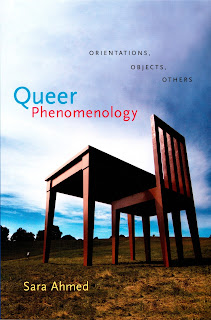Conversations on Science, Culture, and Time
by Michel Serres with Bruno Latour
==================(*)===================
Staging a Conversation
On November 26th, 2013, the MATCH Theory Group staged a reading of a conversation between Michel Serres and Bruno Latour on the possibility of Science Studies.
The 10 minute scene, "For an Antropology of the Sciences" was pulled from the 1990 interview between the scholars, translated from French by Roxanne Lapidus. M.W. Bychowski played the role of Bruno Latour, questioning Patrick Henry who played Michel Serres.
Performed for a small audience and recorded with the help of a respondent, Shyama Rajendran, the praxis of the reading had a three-fold aim: (1) modeling a conversation on science studies, (2) questioning the very possibility of such a conversation, and (3) embodying the material needs and difficulties at stake in the conversation.
==================(*)===================
==================(*)===================
Engaging in Conversation
Serres responds that challenging, success, and failure never leave behind the social enactment of power. It is the "fire" in the rocket's detonation that fuels "the fire" of science and nationalism as collective engagement.
This conversation concludes with a serious debate over whether one mind can think of an object in a scientific and humanist mode at once. Latour challenges that the objects being considered are importantly distinct, that "the fire" that exploded the rocket and the "fire" that fuels a scientist are of two types.
Serres responds that we can and must think both together, asking "isn't it more reasonable to use both hemispheres of the brain in unison?... To walk on two feet seems to trip everyone up. Is this proof, then, that we always limp?"
==================(*)===================
==================(*)===================
Interrogating the Conversation
Following the staged conversation, the respondent helped the speakers explore their experience and reaction to the material they just performed. The responses were surprising.
While in the role of Serres, Henry found himself convinced by many of Latour's refutations. A dangerous conflation can occur, Henry argued, when we as humanists interpret a scientific conversation about the Challenger we take certain words such as fire to signify passion (which is one type of object) when the scientists mean to signify fire as an object of combustion. The result is not only confusion, but a re-instantiation of two separate conversations about two separate things.
Conversely, in the role of Latour, Bychowski found herself convinced by many of Serres's arguments. Fire can do and be many different things, so that an active attention to it would require an understanding of its burning presence in both discourses. Thus accepting the argument that two objects and conversations exist, to create an interdisciplinary Science Studies scientists have to learn Humanist language and Humanists will have to learn scientific methodology.
Coming together on this point, the respondent brought the speakers to imagine where and how this cross-training is already occurring, offering Disability Studies as one such instance. Indeed, noted Henry, we see universities such as Columbia, NYU, and GWU requiring or encouraging their med-students to take courses on "Literature and Medicine" to help them see their work as acting within a wider network of social relations.
Concluding, all present affirmed the value of the exercise of engaging in such a conversation but admitting a certain disciplinary bias. The Humanities has found reasons (especially relating to funding) to reach out into the sciences, but the Sciences appears less interested in pivoting to include the Humanities. There are notable exceptions, of course, such as Karen Barad which we read the month before, but there is much work left to be done and many people left to convince.


+-+Copy+-+Copy+-+Copy.jpg)
+-+Copy.JPG)
















